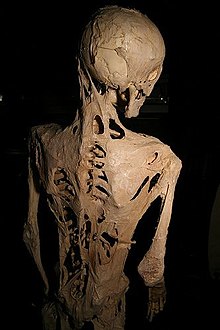Fibrodysplasia ossificans progressiva
| Classification according to ICD-10 | |
|---|---|
| M61.1 | Myositis ossificans progressiva Fibrodysplasia ossificans progressiva |
| ICD-10 online (WHO version 2019) | |
The fibrodysplasia ossificans progressiva (FOP short), also called fibrodysplasia ossificans progressiva multiplex , myositis ossificans progressiva or Münchmeyer syndrome , morbid, progressive describes ossification of the connective and supporting tissues of the human body .
The name Münchmeyer syndrome is derived from Ernst Münchmeyer (1846–1880), who described the disease in 1869.
frequency
The disease was first mentioned in 1692 by Guy Patin . FOP can be inherited in an autosomal dominant manner , but it is rare for people with FOP to have children. This also leads to the low spread. About 600 cases are currently known to medicine worldwide. However, several thousand cases can be assumed worldwide. According to one statistic, only one in 2 million is affected, which corresponds to around 3,250 people at the moment. Since FOP is one of the rarest diseases in the world, it was long unexplored. American scientists did not begin to investigate the circumstances until the end of the 20th century , mainly with the help of genetic research . The pediatrician Michael Zasloff and the orthopedic surgeon Fred Kaplan have made great contributions to previous research into the disease . In 1997, the first research results on the cause were published.
Cause of illness
The disease arises from the lack of a signal to switch off a gene that controls skeletal growth during the development of a fetus . As a result, the fibrocytes develop bones instead of normal scar tissue during wound healing , which leads to the body slowly stiffening even with the smallest injuries.
Detection / symptoms
Signs of this disease, the shortened and twisted big toes of the feet, can already be seen after birth. When the disease breaks out, areas of the body become bloated and become very hot. The blood vessels are then clearly visible. After a few days, the tissue recedes again. However, you can now see on X-rays that new bones have formed here.
course
Most often, due to the circumstances of its genesis, this disease is top-down. So the muscles and the connective and supporting tissue in the neck, neck and shoulders are affected first, and later in the arms, chest, stomach, pelvis up to the legs and feet. In addition, injuries to muscle tissue (for example, bruises , tears, cuts and punctures) can cause additional bone growth . For this reason, it is strongly recommended not to give intramuscular injections or even to remove the affected tissue. With advancing age, most patients experience impairment of lung function due to reduced chest mobility.
Therapy / chances of recovery
At the moment there is no therapy for treatment and no way to prevent FOP.
At the moment, research is being carried out into drugs that are intended to prevent new FOP attacks or at least reduce their effect. Important findings on this path are:
- Isolation of the gene that controls the formation of bone morphogenetic protein (BMP)
- Scientific proof of the cause of the disease using a similar fly gene: After mutating this gene, the genetically modified flies of FOP showed similar symptoms .
- Discovery of a gene (noggin) in mice that can stop bone deposition
- Lymphocytes in FOP patients attack the body's own muscle cells when they are injured ; they transport the bone-forming BMP to the wound.
- Discovery of a substance in sharks that prevents the formation of bones from cartilage . The substance is considered to be the greatest hope for the treatment of FOP.
literature
- FS Kaplan, M. Le Merrer, DL Glaser, RJ Pignolo, RE Goldsby, JA Kitterman, J. Groppe, EM Shore: Fibrodysplasia ossificans progressiva. In: Best Pract Res Clin Rheumatol . 2008 Mar; 22 (1), pp. 191-205. Review. PMID 18328989
